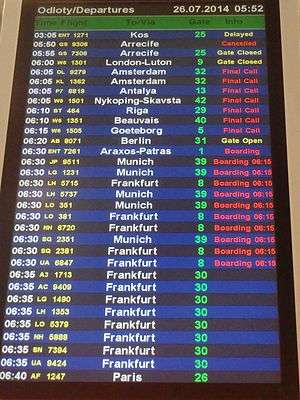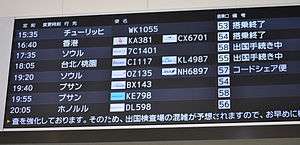Codeshare agreement


A codeshare agreement, sometimes simply codeshare, is an aviation business arrangement where two or more airlines share the same flight. Sharing, in this sense, means that each airline publishes and markets the flight under its own airline designator and flight number as part of its published timetable or schedule. A seat can be purchased on each airline's designator and flight number, but is operated by only one of these cooperating airlines, commonly called the operating carrier or more precisely (and in line with definitions in IATA Standard Schedules Information Manual): "Administrating carrier". The term "code" refers to the identifier used in flight schedule, generally the two-character IATA airline designator code and flight number. Thus, XX123 (flight number 123 operated by the airline XX), might also be sold by airline YY as YY456 and by ZZ as ZZ9876. Airlines YY and ZZ are in this case called "Marketing airlines" (sometimes abbreviated MKT CXR for "marketing carrier"). Most of the major airlines today have code sharing partnerships with other airlines, and code sharing is a key feature of the major airline alliances. Typically, code-sharing agreements are also a part of the commercial agreements between airlines in the same airline alliances.
Under a code sharing agreement, the airline that administrates the flight (the one holding the operational permissions, airport slots and planning/controlling the flight and responsible for the ground handling services) is commonly called the operating carrier, often abbreviated OPE CXR, even though the IATA SSIM term "Administrating carrier" is more precise. The reason for this is that a third carrier is involved, typically in the case that the airline originally planning to operate the flight needs to hire a subcontractor to operate the flight on their behalf (typically a wet lease, meaning an aircraft is leased with crew and all facilities to fly, commonly due to capacity limitations, technical problems etc.) In this case, the airline carrying the passenger should be designated the operating carrier, since it is the one carrying the passengers/cargo.
When a flight is sold under several designators and flight numbers as described above, the one published by the "Administrating carrier" is commonly called a "prime flight" (as opposed to a codeshare marketing flight).
Several types of codeshare exist, commonly three types:
- Block space codeshare: A commercial (marketing) airline purchases a fixed number of seats from the administrating (operating/prime) carrier. A fixed price is typically paid, and the seats are kept away from the Administrating carrier's own inventory. The marketing airline decides on their own which booking classes the seats are sold in (the block of seats are optimised just like another aircraft cabin).
- Free flow codeshare: The airlines' inventory and reservation systems communicate in real-time by messaging, commonly IATA AIRIMP/PADIS messaging (TTY and EDIFACT). A booking class mapping is defined between the airlines. No seats are locked to any of the airlines, and any airline can sell any number of seats.
- Capped free flow: Basically the same as above, but a capping (max number of seats) are defined for each of the marketing airlines participating in the codeshare with the Administrating (operating/prime) carrier.
History
In 1967, Richard A. Henson joined with US Airways predecessor, Allegheny Airlines, in the nation's first codeshare relationship.[1] The term "code sharing" or "codeshare" was coined in 1989 by Qantas and American Airlines,[2] and in 1990 the two firms provided their first codeshare flights between an array of Australian cities and U.S. domestic cities. Code sharing has become widespread in the airline industry since that time, particularly in the wake of the formation of large airline "alliances." These alliances have extensive codesharing and networked frequent flyer programs.
Reasons and advantages
Under a code sharing agreement, participating airlines can present a common flight number for several reasons, including:
For passengers
- Connecting flights: This provides clearer routing for the customer, allowing a customer to book travel from point A to C through point B under one carrier's code, instead of a customer booking from point A to B under one code, and from point B to C under another code. This is not only a superficial addition as cooperating airlines also strive to synchronize their schedules and coordinate luggage handling, which makes transfers between connecting flights less time-consuming.
- Shared responsibility between the carriers: When flying between two cities without a single-airline connection, the passenger can pick a codeshared flight over two airlines or two flights booked separately. If the flights are not codeshared, then the second airline has no responsibility if the passenger or luggage misses the second flight due to a delay with the first. Under a codeshared flight, the second airline is unlikely to charge extra fees or deny boarding should the first, cooperating airline cause a delay.
For airlines
- Flights from both airlines that fly the same route: this provides an apparent increase in the frequency of service on the route by one airline
- Perceived service to unserviced markets: this provides a method for carriers who do not operate their own aircraft on a given route to gain exposure in the market through display of their flight numbers.
- When an airline sacrifices its capacity to other airlines as a code share partner, its operational cost will generally be reduced to zero.[3]
Competitive concerns
Much competition in the airline industry revolves around ticket sales (also known as "seat booking") strategies (revenue management, variable pricing, and geo-marketing). Criticism has been leveled against code sharing by consumer organizations and national departments of trade since it is claimed it is confusing and not transparent to passengers.[4]
Air-rail alliances
There are also code sharing agreements between airlines and rail lines. These are more formally known as an air-rail alliance, but more commonly known as "Rail & Fly" due to the popularity of the Deutsche Bahn codeshare with many airlines.[5] They involve some integration of both types of transport, e.g., in finding out the fastest connection, allowing exchange between an air ticket and a train ticket, or a step further, the air ticket being valid on the train, etc. In Europe these air-rail alliances are used to divide markets by selling these combination tickets abroad for a lower price to attract more customers. The systems also prevent local customers from buying these much cheaper tickets as the customer is only allowed to board the plane with a valid train stamp from a station outside the country.
See also
References
- ↑ "Piedmont's Roots Run Deep".
- ↑ Financial Review, November 21, 1989
- ↑ Sharkey, Joe (December 5, 2011). "Forget the Airline's Name; It's All About Alliances". The New York Times. Retrieved December 28, 2011.
- ↑ "What the Heck Is a Codeshare, Anyway?". ABC News.
- ↑ Rail&Fly
External links
| Look up codeshare in Wiktionary, the free dictionary. |
- Snyder, Brett. "This isn't the airline I signed up for." CNN. July 11, 2011.
- Article on prospect of codesharing between North American rail and airline connections